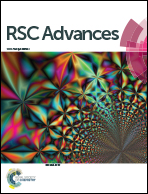Synthesis of MoO2 hierarchical peony-like microspheres without a template and their application in lithium ion batteries†
Abstract
Three dimensional hierarchical structures constructed with low dimensional nanoscale building blocks have become a new research focus for lithium storage. Some hierarchical structured compounds, such as V2O5, Co3O4 and MoS2 micro/nanoflowers, have been synthesized for energy storage applications. However, it still remains a challenge to fabricate well-designed hierarchical MoO2 microflowers. This paper reports on a morphology-controlled synthesis of hierarchical peony-like MoO2 microspheres as an anode material for lithium-ion batteries. This hierarchical structure is fabricated via a simple template-free solvothermal method. The as-derived hierarchical MoO2 microspheres exhibit high specific capacity, high capacity retention, and remarkable cycling stability, when evaluated as an anode material for LIBs.


 Please wait while we load your content...
Please wait while we load your content...